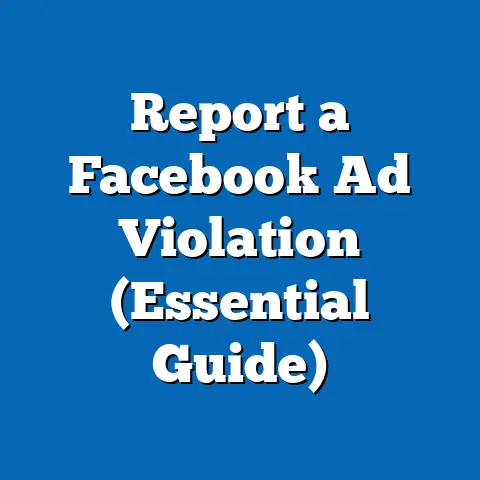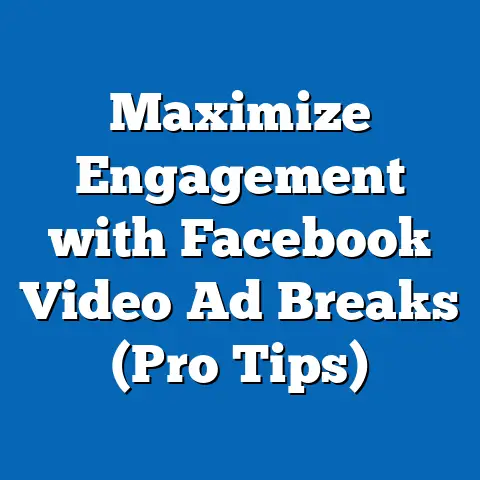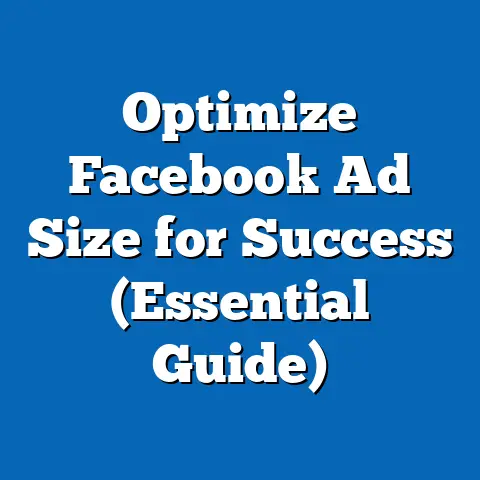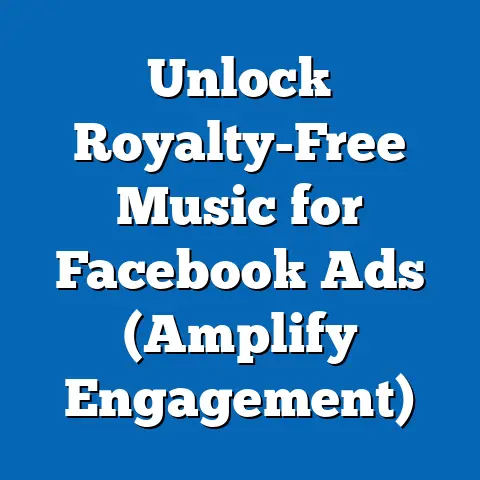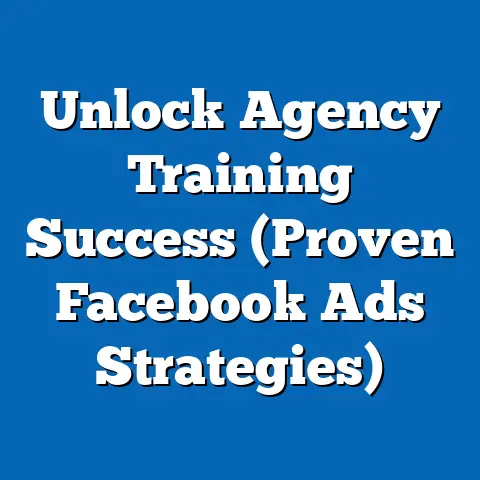Mastering Facebook Ad Payments (Essential Guide for Marketers)
The world of digital marketing is a relentless race. Trends shift, algorithms change, and what worked yesterday might be obsolete tomorrow. To thrive in this environment, you need more than just creativity and a good product – you need resilience. You need the ability to adapt, learn, and overcome challenges. And one of the most crucial, yet often overlooked, aspects of Facebook advertising that demands this resilience is understanding and mastering Facebook ad payments.
I’ve seen countless campaigns derailed, budgets mismanaged, and opportunities lost simply because marketers didn’t grasp the intricacies of the payment system. It’s not just about slapping in a credit card and hoping for the best. It’s about understanding payment methods, budgeting strategies, billing cycles, troubleshooting issues, leveraging credits, and analyzing data to make informed decisions.
Think of it this way: you can have the most brilliant ad creative and the most laser-focused targeting, but if your payment fails, your campaign grinds to a halt. All that hard work goes to waste. That’s why mastering Facebook ad payments is essential for optimizing your ad spend, achieving better campaign results, and ultimately, driving business growth.
In this guide, I’ll walk you through everything you need to know to navigate the often-murky waters of Facebook ad payments. I’ll share my personal experiences, insights, and practical tips to help you avoid common pitfalls and maximize your advertising ROI. Let’s dive in!
Understanding Facebook Ad Payments
At its core, Facebook ad payments are simply the financial transactions required to run your advertising campaigns on the platform. But it’s much more than just a simple exchange of money. It’s the lifeblood of your campaigns, enabling you to reach your target audience and achieve your marketing goals.
Why is it so important? Well, consider this: Facebook is a business, and like any business, it needs to get paid for its services. When you run an ad on Facebook, you’re essentially renting space on their platform to reach their users. Your payment ensures that your ad continues to be displayed to your target audience.
Think of it like renting an apartment. You can have the perfect furniture and decor, but if you don’t pay the rent, you’ll be evicted. Similarly, you can have the most compelling ad creative and the most sophisticated targeting strategy, but if your payment fails, your ad campaign will be shut down.
Types of Payment Methods Accepted
Facebook offers a variety of payment methods to cater to advertisers around the globe. Understanding these options is crucial for choosing the one that best suits your needs and preferences. Here’s a breakdown of the most common payment methods:
- Credit/Debit Cards: This is the most widely used payment method, offering convenience and ease of use. Facebook accepts major credit and debit cards like Visa, Mastercard, American Express, and Discover. I personally prefer using a credit card with rewards points to earn cashback or travel miles on my ad spend.
- PayPal: PayPal is a popular online payment platform that allows you to securely link your bank account or credit card. It offers an extra layer of security and can be a good option if you’re hesitant to directly enter your credit card information on Facebook.
- Direct Bank Transfers: In some regions, Facebook allows you to pay directly from your bank account. This option is often available in countries where credit card usage is less prevalent.
- Facebook Ad Credits: These are promotional credits that Facebook sometimes offers to new advertisers or as part of special promotions. I’ll discuss how to use these credits later in this guide.
- Local Payment Methods: Depending on your location, Facebook may offer other local payment methods that are popular in your region.
Payment Models: CPC, CPM, CPA
Understanding the different payment models is crucial for budgeting and cost management. Facebook offers several options, each with its own pros and cons:
- Cost Per Click (CPC): With CPC bidding, you pay each time someone clicks on your ad. This is a good option if your goal is to drive traffic to your website or landing page. I often use CPC bidding when I’m running ads to generate leads or drive sales.
- Cost Per Mille (CPM): CPM, also known as cost per thousand impressions, means you pay for every 1,000 times your ad is shown to users, regardless of whether they click on it or not. CPM is effective for brand awareness campaigns where your primary goal is to get your message in front of as many people as possible.
- Cost Per Action (CPA): CPA bidding allows you to pay only when someone takes a specific action, such as making a purchase, filling out a form, or downloading an app. This is the most results-oriented bidding option, but it requires careful tracking and optimization to ensure that you’re getting a good return on your investment. I love CPA bidding because it aligns your ad spend with concrete business outcomes.
Key Takeaway: Understanding the different payment methods and models is the foundation for effective Facebook ad management. Choose the options that best align with your business goals and risk tolerance.
Setting Up Your Payment Method
Now that you understand the basics of Facebook ad payments, let’s dive into the practical steps of setting up your payment method in Ads Manager. This is a crucial step, as an incorrectly configured payment method can lead to ad disapprovals and campaign disruptions.
Step-by-Step Guide
- Access Ads Manager: Log in to your Facebook account and navigate to Ads Manager. You can usually find it in the left-hand menu or by searching for “Ads Manager” in the search bar.
- Go to Billing: In Ads Manager, click on the “Billing” tab. This will take you to the payment settings page.
- Add Payment Method: Click on the “Add Payment Method” button. This will open a pop-up window where you can enter your payment information.
- Choose Payment Method: Select your preferred payment method from the available options (credit/debit card, PayPal, etc.).
- Enter Payment Details: Fill in the required information, such as your credit card number, expiration date, and CVV code. Make sure to double-check all the information to avoid errors.
- Set Billing Currency and Location: Choose the correct billing currency and location. This is important for accurate billing and tax calculations.
- Save Changes: Click on the “Save” button to save your payment method.
Pro Tip: I always recommend adding a backup payment method in case your primary payment method fails. This will ensure that your ads continue to run without interruption.
Keeping Payment Information Updated
It’s crucial to keep your payment information updated to avoid disruptions in your ad campaigns. Expired credit cards, outdated billing addresses, and incorrect CVV codes are common reasons for payment failures.
I make it a habit to check my payment information at least once a month to ensure that everything is up-to-date. You can also set a reminder in your calendar to review your payment settings regularly.
Key Takeaway: Setting up your payment method correctly and keeping it updated is essential for smooth and uninterrupted ad campaigns.
Budgeting for Facebook Ads
Budgeting is a critical aspect of Facebook advertising. It’s not just about setting a number and hoping for the best. It’s about strategically allocating your resources to achieve your desired outcomes.
Daily Budget vs. Lifetime Budget
Facebook offers two main budgeting options:
- Daily Budget: With a daily budget, you set the average amount you’re willing to spend each day. Facebook will then try to spend that amount each day, but it may fluctuate slightly depending on the performance of your ads. I often use daily budgets for ongoing campaigns that I want to run consistently.
- Lifetime Budget: With a lifetime budget, you set the total amount you’re willing to spend over the entire duration of your campaign. Facebook will then try to spread your budget evenly over the campaign period. Lifetime budgets are useful for campaigns with a specific end date, such as a product launch or a seasonal promotion.
Effective Budget Allocation
How do you decide how much to spend on your Facebook ads? There’s no one-size-fits-all answer, as it depends on your business goals, target audience, and industry. However, here are some general guidelines:
- Start Small: If you’re new to Facebook advertising, start with a small budget and gradually increase it as you gain experience and see positive results.
- Consider Your Target Audience: The larger your target audience, the more you’ll need to spend to reach them effectively.
- Factor in Your Industry: Some industries are more competitive than others, which means you’ll need to spend more to stand out.
- Test Different Budgets: Experiment with different budget levels to see what works best for your campaigns.
Pro Tip: I always recommend using Facebook’s “Campaign Budget Optimization” (CBO) feature, which allows you to set a budget at the campaign level and let Facebook automatically allocate it to the best-performing ad sets.
Monitoring and Adjusting Budgets
Budgeting is not a set-it-and-forget-it task. You need to monitor your ad spend regularly and adjust your budgets as needed to optimize performance.
I typically check my ad spend at least once a day to see how my campaigns are performing. If I notice that an ad set is underperforming, I’ll either pause it or reduce its budget. Conversely, if an ad set is performing well, I’ll increase its budget to scale up the results.
Key Takeaway: Effective budgeting is a continuous process of planning, monitoring, and adjusting your ad spend to achieve your desired outcomes.
Payment Thresholds and Billing Cycles
Understanding payment thresholds and billing cycles is crucial for managing your cash flow and avoiding unexpected charges.
What are Payment Thresholds?
Payment thresholds are the amounts that trigger a charge on your payment method. For example, if your payment threshold is $25, Facebook will charge your payment method every time your ad spend reaches $25.
Facebook automatically sets your initial payment threshold based on your location and payment history. As you consistently pay your bills on time, your payment threshold may increase over time.
Billing Cycles
Facebook’s billing cycle is typically monthly, but you may be charged more frequently if you reach your payment threshold before the end of the month.
I always recommend checking your billing statements regularly to ensure that you’re being charged correctly. You can find your billing statements in the “Billing” section of Ads Manager.
Implications of Exceeding Payment Thresholds
If you exceed your payment threshold before the end of the month, Facebook will charge your payment method immediately. This can be problematic if you’re not prepared for the charge or if your payment method fails.
To avoid this, I recommend monitoring your ad spend closely and increasing your payment threshold if necessary. You can contact Facebook support to request a higher payment threshold.
Key Takeaway: Understanding payment thresholds and billing cycles is essential for managing your cash flow and avoiding unexpected charges.
Troubleshooting Payment Issues
Even with the best planning, payment issues can still arise. It’s important to know how to troubleshoot these issues quickly and effectively to minimize disruptions to your ad campaigns.
Common Payment Issues
- Failed Transactions: This is perhaps the most common payment issue. It can be caused by a variety of factors, such as insufficient funds, incorrect payment information, or security restrictions.
- Declined Cards: Your credit card may be declined if it’s expired, blocked, or has reached its credit limit.
- Payment Method Not Accepted: Facebook may not accept your payment method if it’s not supported in your region or if it’s associated with fraudulent activity.
- Account Restrictions: In some cases, your Facebook account may be restricted due to policy violations or suspicious activity, which can prevent you from running ads.
Troubleshooting Steps
- Check Payment Information: Double-check your payment information to ensure that it’s accurate and up-to-date.
- Contact Your Bank: If your credit card is being declined, contact your bank to see if there are any issues with your account.
- Try a Different Payment Method: If your primary payment method is not working, try using a different payment method.
- Contact Facebook Support: If you’ve tried all the above steps and you’re still having trouble, contact Facebook support for assistance.
Contacting Facebook Support
Navigating Facebook’s customer service can be tricky. Here are some tips to help you get the support you need:
- Be Patient: Facebook’s support team is often overloaded, so it may take some time to get a response.
- Be Clear and Concise: When contacting support, clearly explain your issue and provide all the relevant information.
- Provide Screenshots: Screenshots can be helpful for illustrating your problem and helping the support team understand your issue.
- Be Persistent: If you don’t get a satisfactory response, don’t give up. Keep following up until you get the help you need.
Key Takeaway: Troubleshooting payment issues requires a systematic approach and a willingness to be persistent. Don’t hesitate to contact Facebook support if you’re unable to resolve the issue on your own.
Utilizing Facebook Ad Credits and Promotions
Facebook often offers ad credits and promotional offers to new advertisers or as part of special promotions. These credits can be a great way to boost your ad spend without increasing your budget.
Finding and Applying Ad Credits
You can usually find ad credit offers in your Ads Manager account or in your Facebook notifications. To apply an ad credit to your campaign, simply select it as your payment method when setting up your ad.
Strategic Use of Ad Credits
Ad credits are typically subject to certain terms and conditions, such as expiration dates and spending limits. To maximize the value of your ad credits, use them strategically on campaigns that are likely to generate a positive ROI.
I often use ad credits to test new ad creatives or targeting options. This allows me to experiment without risking my own money.
Key Takeaway: Facebook ad credits can be a valuable resource for boosting your ad spend, but it’s important to use them strategically and understand the terms and conditions.
Analyzing Payment Data for Better Decisions
Payment data is a goldmine of information that can help you optimize your advertising strategies and improve your ROI.
Importance of Analyzing Payment Data
By analyzing your payment data, you can gain insights into:
- Ad Spend Efficiency: How effectively are you spending your ad budget?
- Campaign Performance: Which campaigns are generating the best results?
- ROI: What is your return on investment for your Facebook ads?
- Payment Trends: Are there any patterns or trends in your payment data that you should be aware of?
Metrics to Track
- Cost Per Click (CPC): The average cost you pay for each click on your ad.
- Cost Per Mille (CPM): The cost you pay for every 1,000 impressions of your ad.
- Cost Per Action (CPA): The cost you pay for each desired action, such as a purchase or a lead.
- Conversion Rate: The percentage of people who take a desired action after clicking on your ad.
- Return on Ad Spend (ROAS): The revenue you generate for every dollar you spend on Facebook ads.
Using Insights to Adjust Campaigns
By tracking these metrics and analyzing your payment data, you can identify areas where you can improve your campaigns and increase your ROI.
For example, if you notice that your CPC is high, you may need to refine your targeting or improve your ad creative. If your conversion rate is low, you may need to optimize your landing page or offer a more compelling incentive.
Key Takeaway: Analyzing payment data is essential for making informed decisions and optimizing your Facebook advertising campaigns for maximum ROI.
Future Trends in Facebook Ad Payments
The world of digital marketing is constantly evolving, and Facebook ad payments are no exception. It’s important to stay informed about emerging trends and developments in this area to stay ahead of the curve.
Potential Developments
- Cryptocurrency Payments: Facebook may eventually allow advertisers to pay for their ads using cryptocurrencies like Bitcoin or Ethereum.
- New Payment Platforms: Facebook may integrate with new payment platforms that offer more convenient and secure payment options.
- AI-Powered Payment Optimization: Facebook may use artificial intelligence to automatically optimize your payment settings and maximize your ROI.
Staying Informed
To stay informed about new features and updates from Facebook regarding payments, I recommend:
- Following the Facebook Business Blog: This blog is a great source of information about new features and updates.
- Subscribing to Industry Newsletters: Many industry newsletters cover Facebook advertising news and trends.
- Attending Industry Conferences: Industry conferences are a great way to learn about the latest trends and network with other marketers.
Key Takeaway: Staying informed about future trends in Facebook ad payments is essential for adapting to change and maintaining a competitive edge.
Conclusion
Mastering Facebook ad payments is not just a technical skill – it’s a strategic imperative for long-term success in digital marketing. It requires patience, perseverance, and a willingness to learn and adapt.
I know that navigating the complexities of Facebook’s payment system can be daunting, but I hope this guide has provided you with the knowledge and tools you need to succeed. Remember, understanding these financial intricacies can lead to more effective ad campaigns, better ROI, and ultimately, drive business growth.
So, embrace the challenge, stay curious, and never stop learning. The world of Facebook advertising is constantly evolving, and the marketers who thrive are those who remain resilient and adaptable. Keep experimenting, keep analyzing, and keep optimizing. Your success is waiting just around the corner.

